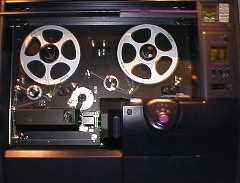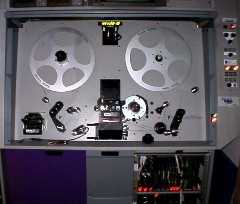Cintel

Cintel International Ltd is a British company, based in Ware, Hertfordshire, which specialises in the design and manufacture of professional post-production equipment, for transcribing film into video or data formats. It was formerly part of the Rank Organisation.
Their main products are based on either cathode ray tube (CRT) or charge coupled device (CCD) technology and include, like the diTTo, diTTo Evolution & dataMill film scanners, Millennium II, Millennium HD & C-Reality & DSX telecines, imageMill 1 & 2 image processing system.

Many movies and TV shows for TV were transferred from film to TV on Cintel Telecines. Cintel saw reduced sales when their competitor came out with the Spirit DataCine in 1996.
As of June 2012 the business is in administration.[1]
On July 24, 2012 Blackmagic Design announced the acquisition of the assets of Cintel International.[2]
History
- 1927 John Logie Baird founds the Baird Television Company, which later becomes Cinema-Television and then Cintel.[3]
- During the Second World War, Cintel supplies thousands of specialist photoelectric cells, and cathode ray tubes for the war effort.
- 1950 The first flying spot telecine was installed at the BBC's Lime Grove Studios.
- 1958 Cinema-Television Limited was renamed Rank Cintel Limited.
- 1946 TMk1 shown using a polygonal prism system, it was the first 35mm continuous Motion Flying Spot Telecine.
- 1964 The model Mk II Telecine with twin lens was shown it supported both 35mm and 16mm.
- 1977 The first Rank Cintel Flying Spot Scanner was introduced into North America by MPV, (Motion Picture Video Corporation, Toronto) and the first colorist and pan & scan operator was the then president Bob Sher.
- The Model Mk III used a new system called jump scan.
- 1987 the model MK IIIB was shown it used a progressive scan CRT and a Digiscan system to make SDTV.
- Mk IIIC was the next generation Digiscan, with improvements
- 1989 the Ursa 4:2:2 with D1 color space output was shown.
- 1993 the Ursa Gold with 4:4:4 output was shown.
- 1993 the Rank Cintel Mk III with HDTV high definition was shown.
- 1997 the Ursa Diamond, with many third-party improvements added was shown.
- OSCAR was added as an optical dust and scratch removal system for their telecines.
- C-Reality was a HD telecine with a Data option for DI work.
- 2002 the DSX telecine HD and Data was shown.
- 2002 Cintel acquired Innovation TK, including the Millennium HD and Data Telecine.
- 2003 Cintel launches GRACE, an internal Film Grain Reducer option for C-Reality and DSX machines
- Millennium II
- 2004 they shown the dataMill fast data scanner based on Millennium 2 technology
- 2004 the GRACE system was shown as an external film grain reducer
- Millennium HD
- ImageMill 1 (video)
- 2005 diTTo - was shown as a low end 2K data scanner, with a 3K native sensor
- diTTo Evolution
- ImageMill 2 ( data)
- OCEAN controller

Notes
References
- Digital Content Producer Millimeter, A Brief History of Film-to-Tape: With DTV and HDTV-What's Next?, Feb 1, 1998, by .W. Leitner
- A Brief History for Colorists from finalcolor.com
- The History of Television, 1942 to 2000 By Albert Abramson, Christopher H. Sterling